HONDA ACCORD SEDAN 2001 (in English) User Guide
Manufacturer: HONDA, Model Year: 2001, Model line: ACCORD SEDAN, Model: HONDA ACCORD SEDAN 2001Pages: 372, PDF Size: 6.1 MB
Page 11 of 372
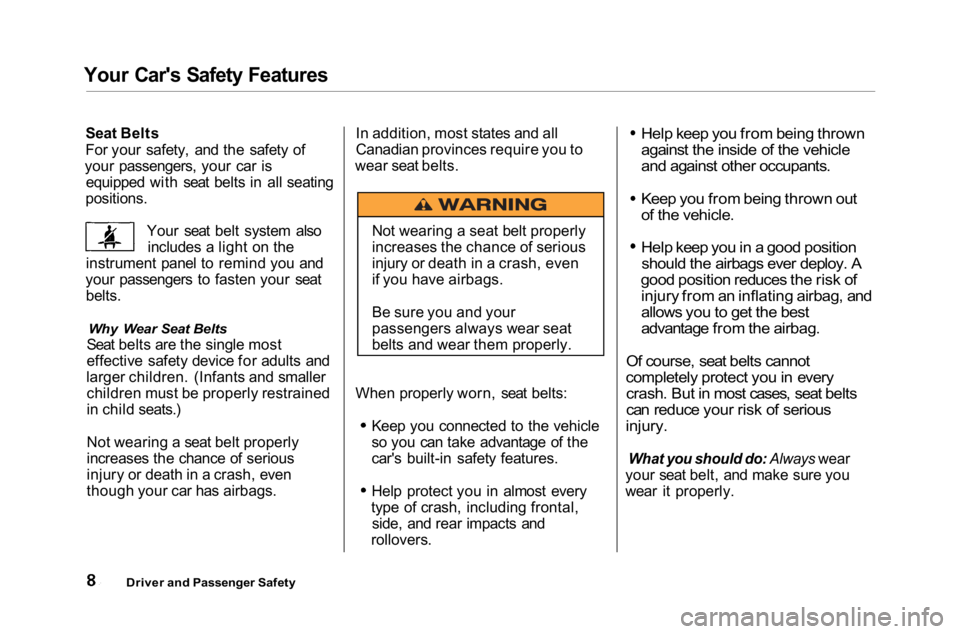
Your Car's Safety Features
Seat Belts
For your safety, and the safety of
your passengers, your car is equipped with seat belts in all seating
positions.
Your seat belt system alsoincludes a light on the
instrument panel to remind you and
your passengers to fasten your seat belts.
Why Wear Seat Belts
Seat belts are the single most
effective safety device for adults and
larger children. (Infants and smaller children must be properly restrained
in child seats.)
Not wearing a seat belt properly
increases the chance of serious
injury or death in a crash, even
though your car has airbags. In addition, most states and all
Canadian provinces require you to
wear seat belts.
When properly worn, seat belts: Keep you connected to the vehicle
so you can take advantage of the
car's built-in safety features.
Help protect you in almost every
type of crash, including frontal, side, and rear impacts and
rollovers.
Help keep you from being thrown
against the inside of the vehicle
and against other occupants.
Keep you from being thrown out
of the vehicle.
Help keep you in a good position
should the airbags ever deploy. A
good position reduces the risk of injury from an inflating airbag, and
allows you to get the best
advantage from the airbag.
Of course, seat belts cannot
completely protect you in every crash. But in most cases, seat belts
can reduce your risk of serious
injury.
What you should do: Always wear
your seat belt, and make sure you
wear it properly.
Driver and Passenger Safety
Not wearing a seat belt properly
increases the chance of serious
injury or death in a crash, even
if you have airbags.
Be sure you and your
passengers always wear seat
belts and wear them properly.
Page 12 of 372
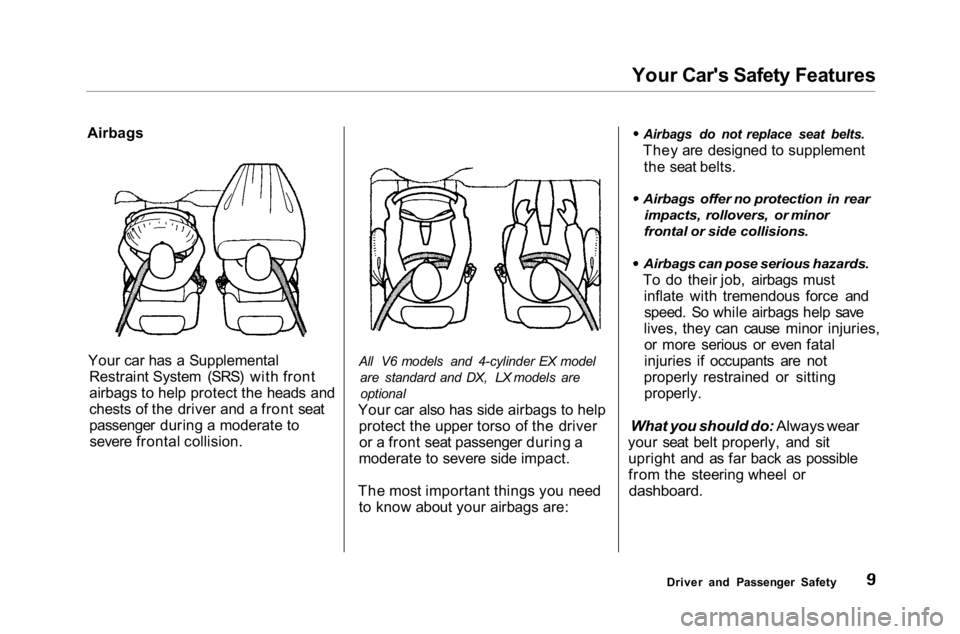
Your Car's Safety Features
Airbags
Your car has a Supplemental Restraint System (SRS) with front
airbags to help protect the heads and
chests of the driver and a front seat
passenger during a moderate tosevere frontal collision. All V6 models and 4-cylinder EX model
are standard and DX, LX models areoptional
Your car also has side airbags to help protect the upper torso of the driveror a front seat passenger during a
moderate to severe side impact.
The most important things you need to know about your airbags are: Airbags do not replace seat belts.
They are designed to supplement the seat belts.
Airbags offer no protection in rear
impacts, rollovers, or minor
frontal or side collisions.
Airbags can pose serious hazards.
To do their job, airbags must inflate with tremendous force andspeed. So while airbags help save
lives, they can cause minor injuries, or more serious or even fatal
injuries if occupants are not
properly restrained or sitting properly.
What you should do: Always wear
your seat belt properly, and sit upright and as far back as possible
from the steering wheel or
dashboard.
Driver and Passenger Safety
Page 13 of 372
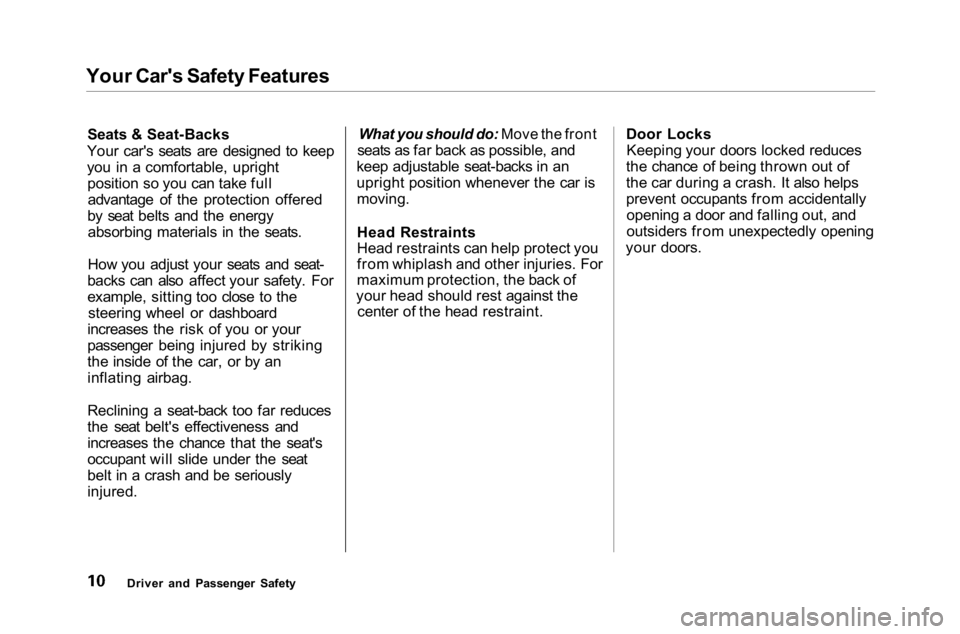
Your Car's Safety Features
Seats & Seat-Backs
Your car's seats are designed to keep
you in a comfortable, upright position so you can take fulladvantage of the protection offered
by seat belts and the energy absorbing materials in the seats.
How you adjust your seats and seat-
backs can also affect your safety. For
example, sitting too close to the steering wheel or dashboard
increases the risk of you or your
passenger being injured by striking
the inside of the car, or by an
inflating airbag.
Reclining a seat-back too far reduces
the seat belt's effectiveness and
increases the chance that the seat's
occupant will slide under the seat
belt in a crash and be seriously
injured.
What you should do: Move the front
seats as far back as possible, and
keep adjustable seat-backs in an
upright position whenever the car is
moving.
Head Restraints
Head restraints can help protect you
from whiplash and other injuries. For
maximum protection, the back of
your head should rest against the center of the head restraint. Door Locks
Keeping your doors locked reduces
the chance of being thrown out of
the car during a crash. It also helps
prevent occupants from accidentally opening a door and falling out, and
outsiders from unexpectedly opening
your doors.
Driver and Passenger Safety
Page 14 of 372
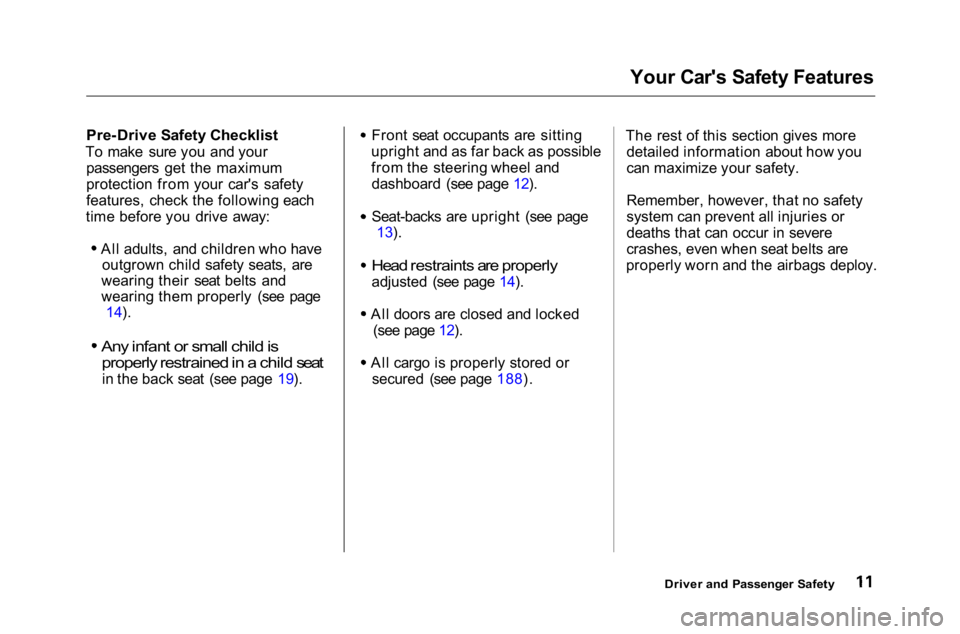
Your Car's Safety Features
Pre-Drive Safety Checklist
To make sure you and your passengers get the maximum
protection from your car's safety
features, check the following each
time before you drive away:
All adults, and children who haveoutgrown child safety seats, are
wearing their seat belts and
wearing them properly (see page 14).
Any infant or small child is properly restrained in a child seat
in the back seat (see page 19). Front seat occupants are sitting
upright and as far back as possible
from the steering wheel and dashboard (see page 12).
Seat-backs are upright (see page 13).
Head restraints are properly
adjusted (see page 14).
All doors are closed and locked (see page 12).
All cargo is properly stored or secured (see page 188). The rest of this section gives more
detailed information about how you
can maximize your safety.
Remember, however, that no safety
system can prevent all injuries or
deaths that can occur in severe
crashes, even when seat belts are
properly worn and the airbags deploy.
Driver and Passenger Safety
Page 15 of 372
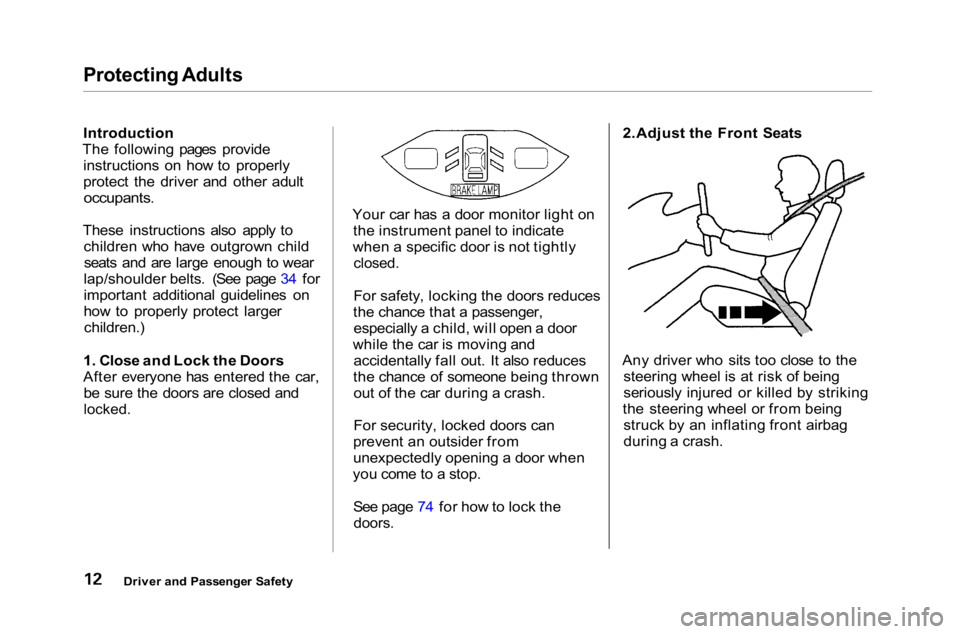
Protecting Adults
Introduction
The following pages provide instructions on how to properly
protect the driver and other adult
occupants.
These instructions also apply to children who have outgrown childseats and are large enough to wear
lap/shoulder belts. (See page 34 for
important additional guidelines on
how to properly protect larger children.)
1. Close and Lock the Doors After everyone has entered the car, be sure the doors are closed and
locked.
Your car has a door monitor light on
the instrument panel to indicate
when a specific door is not tightly
closed.
For safety, locking the doors reduces
the chance that a passenger, especially a child, will open a door
while the car is moving and accidentally fall out. It also reduces
the chance of someone being thrown out of the car during a crash.
For security, locked doors can
prevent an outsider from
unexpectedly opening a door when
you come to a stop.
See page 74 for how to lock the
doors.
2.Adjust the Front Seats
Any driver who sits too close to the steering wheel is at risk of being
seriously injured or killed by striking
the steering wheel or from being struck by an inflating front airbag
during a crash.
Driver and Passenger Safety
Page 16 of 372
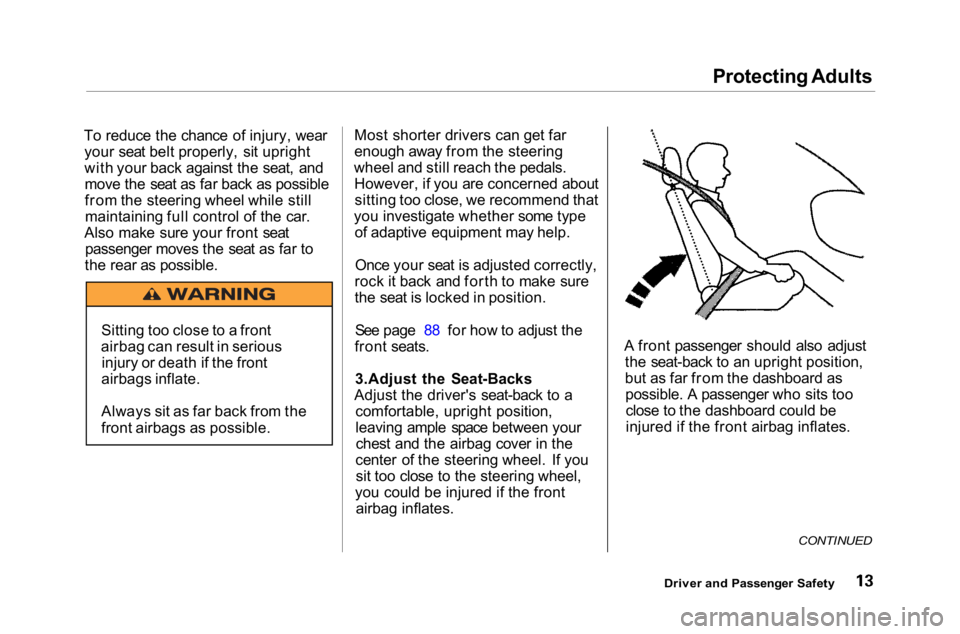
Protecting Adults
To reduce the chance of injury, wear your seat belt properly, sit upright
with your back against the seat, andmove the seat as far back as possible
from the steering wheel while stillmaintaining full control of the car.
Also make sure your front seat passenger moves the seat as far to
the rear as possible. Most shorter drivers can get far
enough away from the steering
wheel and still reach the pedals. However, if you are concerned aboutsitting too close, we recommend that
you investigate whether some type of adaptive equipment may help.
Once your seat is adjusted correctly,
rock it back and forth to make sure
the seat is locked in position.
See page 88 for how to adjust the
front seats.
3.Adjust the Seat-Backs
Adjust the driver's seat-back to a comfortable, upright position,
leaving ample space between yourchest and the airbag cover in the
center of the steering wheel. If you sit too close to the steering wheel,
you could be injured if the front airbag inflates. A front passenger should also adjust
the seat-back to an upright position,
but as far from the dashboard aspossible. A passenger who sits tooclose to the dashboard could be
injured if the front airbag inflates.
CONTINUED
Driver and Passenger Safety
Sitting too close to a front
airbag can result in serious injury or death if the front
airbags inflate.
Always sit as far back from the
front airbags as possible.
Page 17 of 372
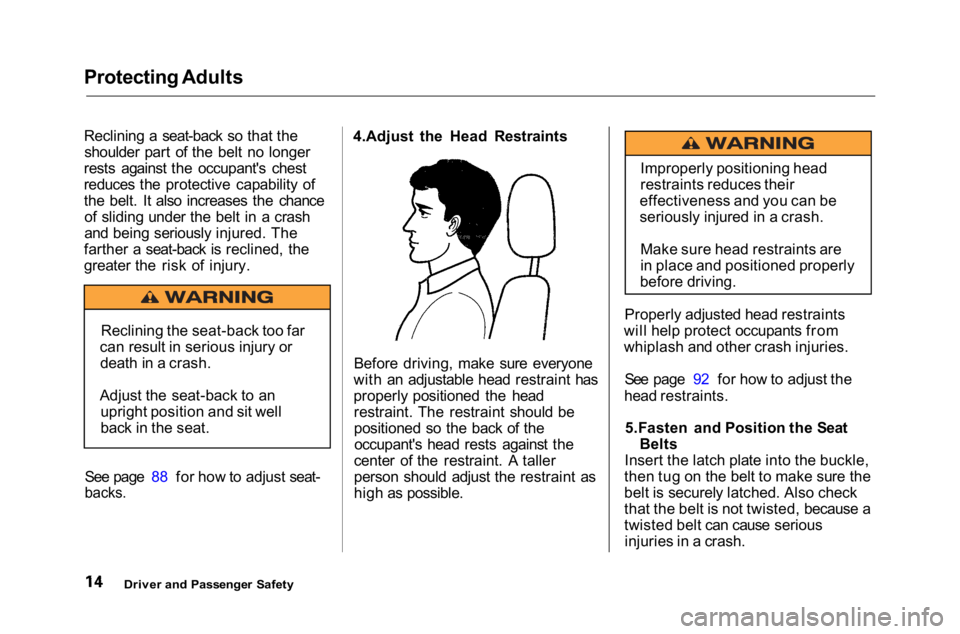
Protecting Adults
Reclining a seat-back so that the
shoulder part of the belt no longer
rests against the occupant's chest
reduces the protective capability of
the belt. It also increases the chance of sliding under the belt in a crash
and being seriously injured. The
farther a seat-back is reclined, the
greater the risk of injury.
See page 88 for how to adjust seat-
backs.
4.Adjust the Head Restraints
Before driving, make sure everyone
with an adjustable head restraint has
properly positioned the head restraint. The restraint should be
positioned so the back of theoccupant's head rests against the
center of the restraint. A taller
person should adjust the restraint as
high as possible. Properly adjusted head restraints
will help protect occupants from
whiplash and other crash injuries.
See page 92 for how to adjust the
head restraints.
5.Fasten and Position the Seat Belts
Insert the latch plate into the buckle,
then tug on the belt to make sure the
belt is securely latched. Also check
that the belt is not twisted, because a
twisted belt can cause serious injuries in a crash.
Driver and Passenger Safety
Improperly positioning head
restraints reduces their
effectiveness and you can be
seriously injured in a crash.
Make sure head restraints are
in place and positioned properly
before driving.
Reclining the seat-back too far
can result in serious injury or death in a crash.
Adjust the seat-back to an upright position and sit well
back in the seat.
Page 18 of 372
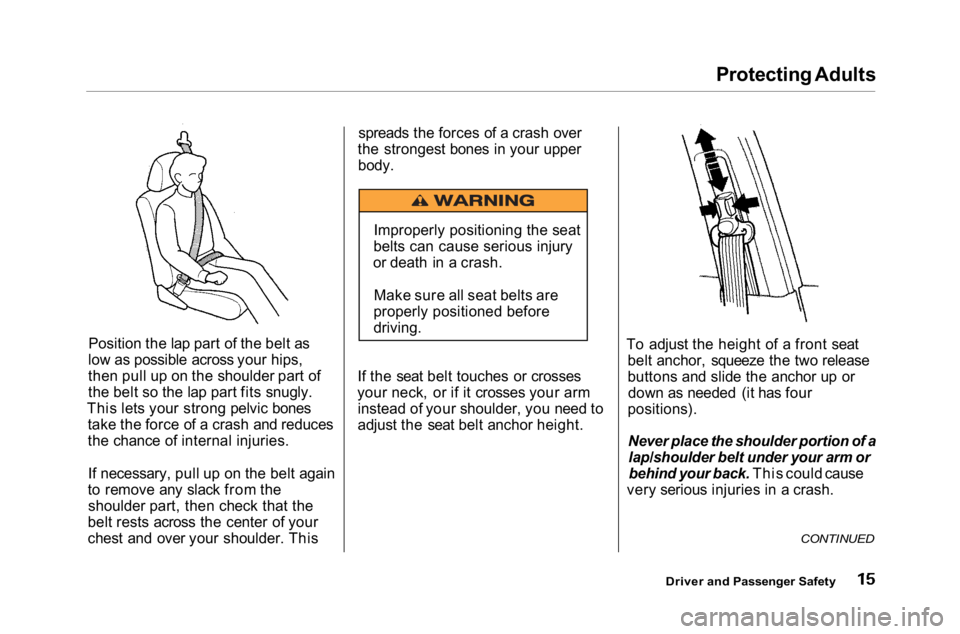
Protecting Adults
Position the lap part of the belt as
low as possible across your hips,
then pull up on the shoulder part of
the belt so the lap part fits snugly.
This lets your strong pelvic bones take the force of a crash and reduces
the chance of internal injuries.
If necessary, pull up on the belt again
to remove any slack from the shoulder part, then check that the
belt rests across the center of your
chest and over your shoulder. This spreads the forces of a crash over
the strongest bones in your upper body.
If the seat belt touches or crosses
your neck, or if it crosses your arm instead of your shoulder, you need to
adjust the seat belt anchor height. To adjust the height of a front seat
belt anchor, squeeze the two release
buttons and slide the anchor up ordown as needed (it has four
positions).
Never place the shoulder portion of alap/shoulder belt under your arm orbehind your back. This could cause
very serious injuries in a crash.
CONTINUED
Driver and Passenger Safety
Improperly positioning the seat
belts can cause serious injury
or death in a crash.
Make sure all seat belts are
properly positioned before
driving.
Page 19 of 372

Protecting Adults
If a seat belt does not seem to work
as it should, it may not protect the
occupant in a crash. No one should
sit in a seat with an inoperative seat
belt. Anyone using a seat belt that is
not working properly can be seriously injured or killed. Have your
Honda dealer check the belt as soon
as possible.
See page 40 for additional
information about your seat beltsystem and how to take care of your
belts.
6.Adjust the Steering Wheel
Adjust the steering wheel, if needed, so that the wheel points toward your
chest, not toward your face.
Pointing the steering wheel toward
your chest provides optimal protection from the airbag.
See page 67 for how to adjust the
steering wheel.
7.Maintain a Proper Sitting
Position
After all occupants have adjusted their seats and put on seat belts, it is
very important that they continue to sit upright, well back in their seats,
with their feet on the floor, until the car is parked and the engine is off.
Sitting improperly can increase the
chance of injury during a crash. For
example, if an occupant slouches,
lies down, turns sideways, sits
forward, leans forward or sideways, or puts one or both feet up, the
chance of injury during a crash is
greatly increased.
In addition, an occupant who is out of
position in the front seat can be seriously or fatally injured by
striking interior parts of the car, or
by being struck by an inflating front airbag. Being struck by an inflatingside airbag can result in possibly
serious injuries.
Driver and Passenger Safety
Page 20 of 372
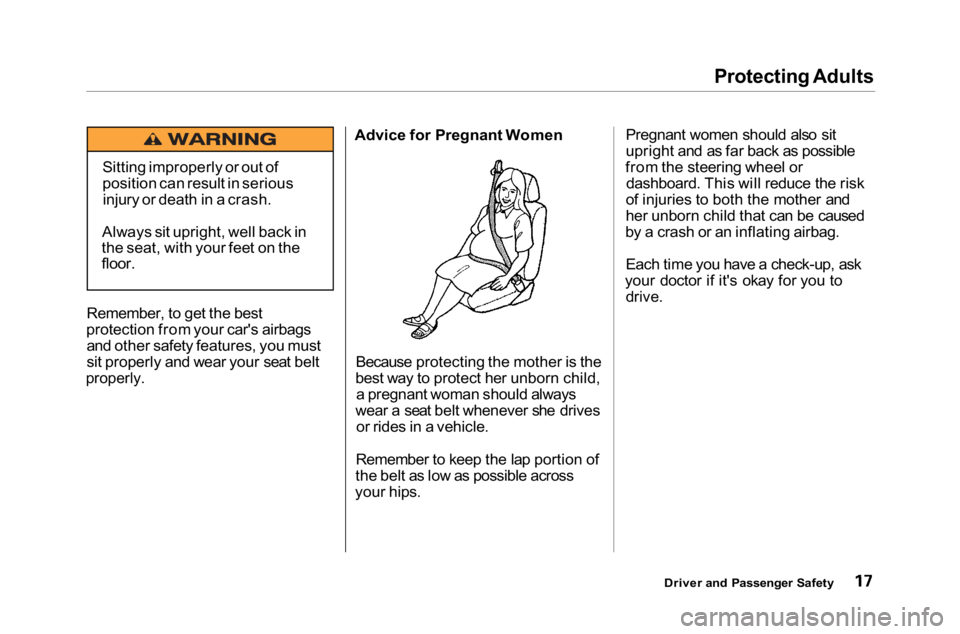
Protecting Adults
Remember, to get the best
protection from your car's airbags and other safety features, you must
sit properly and wear your seat belt
properly.
Advice for Pregnant Women
Because protecting the mother is the
best way to protect her unborn child, a pregnant woman should always
wear a seat belt whenever she drives or rides in a vehicle.
Remember to keep the lap portion of
the belt as low as possible across
your hips. Pregnant women should also sit
upright and as far back as possible
from the steering wheel or dashboard. This will reduce the risk
of injuries to both the mother and
her unborn child that can be caused
by a crash or an inflating airbag.
Each time you have a check-up, ask
your doctor if it's okay for you to
drive.
Driver and Passenger Safety
Sitting improperly or out of
position can result in serious
injury or death in a crash.
Always sit upright, well back in
the seat, with your feet on the
floor.